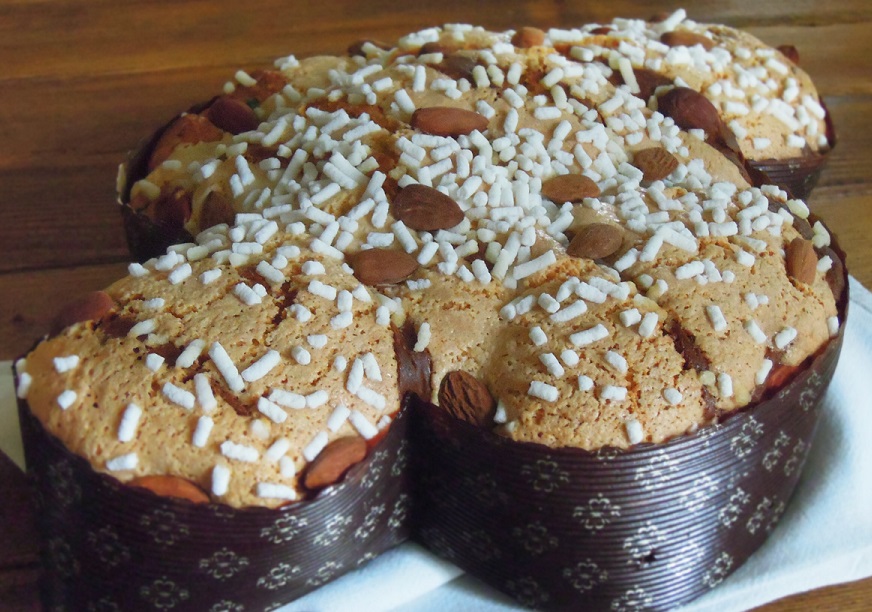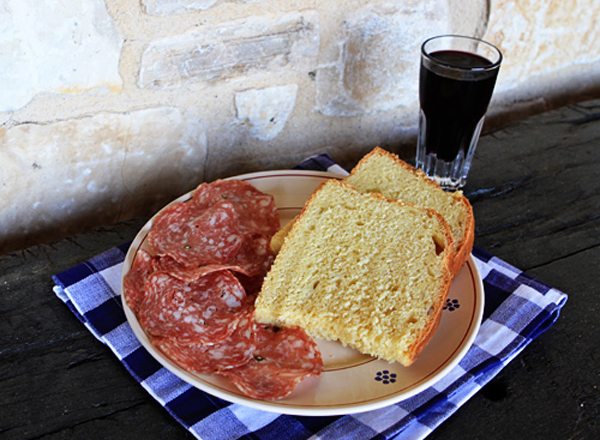Italy’s Pane di Pasqua, Italian Easter Breads, are tangible representations of the meaningful ties to the origins of Easter Sunday, the symbolism of seasonal celebrations and the culinary and cultural traditions of regional Italian food. Here are a selection of Easter Breads from the classic Colomba di Pasqua to a bread from Sardinia an island known for its bakers and a variety of breads made especially for Easter.

Filled with raisins and candied orange peel, the classic Colomba di Pasqua is the most familiar of the traditional Italian Easter breads. Shaped like a dove (colomba means dove in Italian) it is a symbol of peace and the resurrection.

Seasonal Italian Easter breads braided and studded with colorful eggs are made to be the celebratory centerpiece of the Easter table. Flavored with citrus or anise with dotted batters of dried fruit, the knotted shaping and braiding of the bread in loaves or rings is often a signature of a generational family kitchen. Innovative designs symbolize the rebirth of the spring season and Christ’s resurrection with soft, slightly sweet breads and brightly colored eggs.

There are many Italian breads and regional variations to celebrate the Easter season. In the Italian Marche region crescia, a traditional cheese bread, more savory than sweet, is meant to be eaten with cured meats.

Sardinia has hundreds of different varieties of bread. The most unique and recognizable are those breads baked for weddings, festivals or religious occasions known as pane coccoi. With jagged edges and spikes made with scissors, knives and fluted wheels, the dough also includes whole eggs still in their shell.
Italian pane di Pasqua risen breads need not be elaborate or ornate. Here is a recipe for a simple Italian breakfast bread to enjoy Easter morning or brunch to celebrate the season.

Italian Sweet Breakfast Bread
Makes one 10-inch round loaf
2 ½ tsp. active dry yeast
1 cup warm water
2 Tbs.sugar
2 eggs
½ cup plain yogurt
1 teaspoon vanilla extract
1 tablespoon grated lemon zest
1 teaspoon salt
4-5 cups unbleached all-purpose flour
¼ cup golden raisins
¼ cup chopped candied lemon peel
In the bowl of a large stand mixer, combine yeast, water and sugar. Cover and let stand 10 minutes, or until a foamy vital yeast bloom has been formed. Add eggs, yogurt, vanilla, lemon zest, and salt. Mix well. With the paddle attachment of the stand mixer, stir in flour ½ cup at a time, scraping sides of bowl down, until dough starts to form (this should happen after adding about 3 cups). Switch to the dough hook and continue adding flour (about 1 more cup) until dough begins to come together. Continue kneading for 5 to 10 minutes, adding flour as necessary (up to 5 cups), until dough is soft and pliable, but not sticky.
Form dough into a large ball and coat all sides with oil. Let dough rise in a warm place until doubled, about 1 hour. Punch dough down in bowl, transfer to a floured surface, and knead in the dried fruits. The goal is to get the fruits uniformly incorporated throughout the dough. Form dough into a ball and place in a greased 9-10 inch round pan. Cover loosely with plastic wrap and cool rise in the refrigerator overnight.
The next morning, remove pan from refrigerator and let come to room temperature (about 1 hour before baking). Bake in a preheated oven at 350 F for 45 minutes, or until loaf is golden brown and a toothpick inserted in the center comes out clean. (If bread browns too quickly on top, cover with a piece of foil.)





Leave a comment